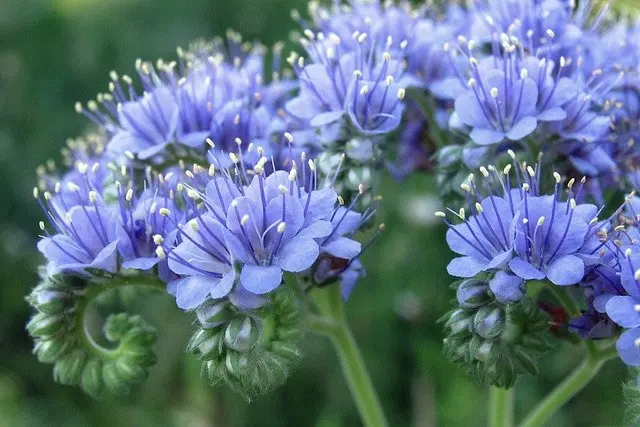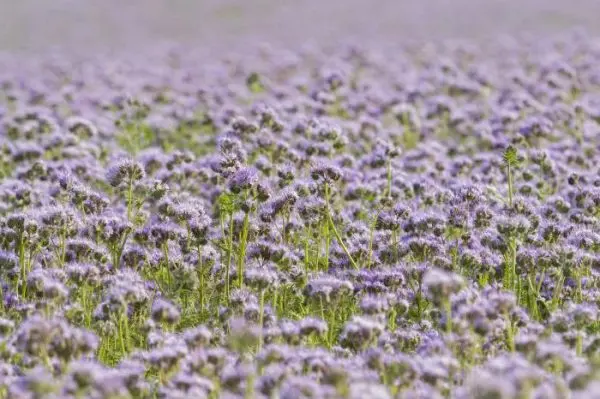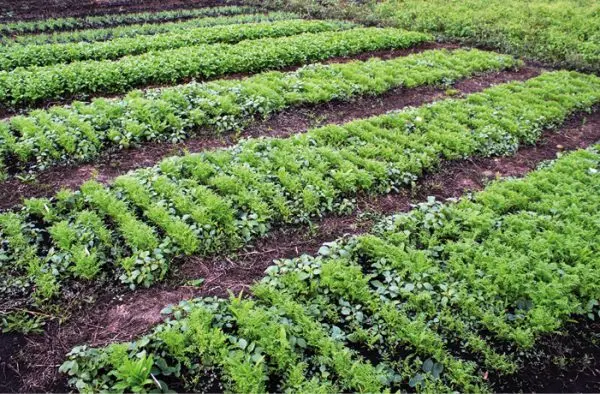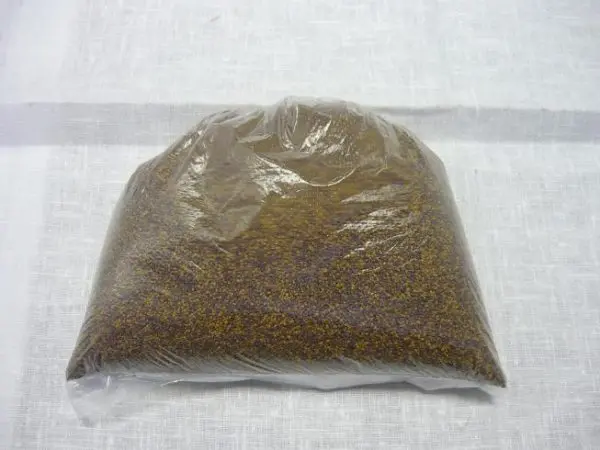Contents
Phacelia tansy is a well-known honey plant. A plant with blue or lilac flowers, growing up to 100 cm, can decorate any suburban area and attract bees to it. Phacelia as green manure can further improve the structure of the soil, fertilize it better than manure, and get rid of many weeds and pests.
Useful Properties
An annual plant of the water-foliate family, phacelia tansy is very unpretentious, grows on all types of soil, without requiring any care. It is satisfied with black soil, peat, clay or sand – in any conditions it grows to a height of 50 cm to 1 m, and very quickly. Flowering time comes 40–45 days after sowing, and it germinates in a week. The root deepens to 20 cm, making the soil lighter and more breathable. The green mass grows quickly, the cut quickly decomposes, enriching the soil with nitrogen fertilizers, which makes it comparable to manure. Only, unlike manure, it does not clog the area with weed seeds.

Phacelia attracts beneficial insects that fight pests, so it is often sown along the perimeter of the garden. And when it grows in the garden, pollination of all fruit trees is ensured. It grows densely enough to keep weeds from developing. Phacelia is planted in empty lands especially for bees. Honey is considered not only tasty, but very useful, it is recommended to be used as an analgesic, antipyretic and antibacterial agent for many diseases. Phacelia is often grown for livestock feed, and in this capacity it is better than many feed mixtures.
This beautiful plant is able to restore fertility to depleted soil, make heavy clay soils much easier, enrich them with useful substances, and make them breathable in a very short time. Literally one year is enough if you sow phacelia several times in one place, planting green mass in the ground before flowering, or at its very beginning. When phacelia grows in the garden, it does not allow weeds to develop, in addition, it also neutralizes acidic soil, which also reduces the number of weeds that are accustomed to acidic soil.
Video “Using Phacelia”
Informative video about the beneficial properties of using phacelia.
When to sow
Siderates are usually sown in early spring so that they have time to grow before planting or sowing the main plant. Phacelia can be sown as soon as the ground is free of snow, it perfectly tolerates not only cold, but even frosts down to -8 degrees. It can be sown in rows or scatter the seeds randomly (small seeds are usually mixed with sand), then harrowed to get a depth of up to 3 – 4 cm. If the earth is at least a little wet, it is not necessary to water. After a week, the grass will sprout, after another 5 it will begin to bloom. Before flowering, it must be cut off, embedded in the ground, digging it up, or left to lie on top – all the same, after decomposition, the nutrients will get to their intended purpose, but for now the grass can serve as mulch. After the start of flowering, the greens will become more rigid, but less rich in nutrients.
Phacelia can be sown at any time, and in the fall too. Immediately after harvesting (literally after a couple of hours) vegetables, it is sown on a vacant garden bed, and then dug up before flowering begins. If the grass has not bloomed before frost, it can be left and dug up in the spring. A plot with poor, heavy, infertile soil can be turned into a complete opposite in 1 year – with the help of phacelia, make it fertile and get a good harvest the next year. To do this, from frost to frost, you need to sow it, cut it off before flowering, dig it up and repeat the whole cycle from the beginning. If you start when the snow melts, and finish just before the frost, you will get at least 4 times.

Small phacelia seeds are mixed with sand (for uniformity) and scattered over the site, can be sown in rows, this will not affect the result. After that, you just need to harrow it so that there is a small layer of earth on top, you can not even water it if the earth is wet after winter. After about 45 days, the grass needs to be dug up. Before this, you can cut with a flat cutter, wait a few days, but not longer, and sow again. Digging allows you to raise the barren layer from a depth equal to the bayonet of a shovel, and lower the grass to the same depth. When such an operation is performed several times, the grass, and therefore nitrogen fertilizers, are distributed at a depth of up to 40 cm. The last time before frost should not be cut off the grass, it is better to leave it for the winter, it will retain more moisture by spring, will not allow the soil to wash out or freeze .
Advantages
Phacelia can protect seedlings from spring cooling or too bright sun. To do this, they first sow it in the garden in early spring, then arrange separate holes among the growing grass, in which zucchini, cabbage, pumpkin, and tomatoes are planted. Tall grass covers from the sun, saves from the wind, retains moisture. And then the phacelia is cut off, leaving it to lie between the growing vegetables, it continues to retain moisture and temperature, and does not allow weeds to grow. Over time, the grass will still turn into fertilizer.

If you sow phacelia in early spring, then 1–200 kg of green mass will grow on 300 weave, which is equivalent to 300 kg of manure in terms of fertilizer quality. Unlike manure, those 150–200 g of seeds sown require much less money and effort, in addition, they do not allow weeds to grow, and manure provokes their growth (there are a lot of seeds in it). Before the main planting of vegetable crops, the phacelia must be cut off, left in the garden in the form of mulch or dug up, driven into the ground.
It’s not hard to get your own phacelia seeds. To do this, you need to leave part of the plants to fade and ripen. Then they are torn off, the bunches are dried in ventilated boxes, the seeds are shaken out of the dry ones.
 The roots of phacelia perfectly loosen the soil, after cutting, even without digging, they decompose, thereby enriching the soil with nutrients. The aboveground and underground parts of the plant, decomposing, saturate the soil with the minerals and compounds it needs. So gradually the soil becomes nutritious, light, breathable. This guarantees a good harvest for subsequent vegetable plantings. It is sown in the aisles of potatoes, after hilling, this helps to retain moisture and looseness of the earth, due to which more moisture and air enter the tubers, which has an excellent effect on the crop.
The roots of phacelia perfectly loosen the soil, after cutting, even without digging, they decompose, thereby enriching the soil with nutrients. The aboveground and underground parts of the plant, decomposing, saturate the soil with the minerals and compounds it needs. So gradually the soil becomes nutritious, light, breathable. This guarantees a good harvest for subsequent vegetable plantings. It is sown in the aisles of potatoes, after hilling, this helps to retain moisture and looseness of the earth, due to which more moisture and air enter the tubers, which has an excellent effect on the crop.
Useful properties of culture
Phacelia makes the soil and the entire environment much healthier. It deoxidizes the soil, this allows you to get rid of some perennial weed plants, grow more vegetables. The aroma of phacelia attracts certain pest-fighting insects. If at least a little of this wonderful plant grows on the site, then there will be significantly fewer codling moths, leafworms, and apple flower beetles on it. Wireworms, nematodes and locusts magically disappear from the beds. There are much fewer cases of late blight and root rot.
If you sow it in a bed with beans, there will be much less weevils, aphids, pea weevil. This unpretentious annual plant with beautiful flowers can do wonders in a summer cottage. It will heal the entire area, get rid of pests and weeds, attract bees and bumblebees, structure and fertilize the soil.
Video “Sown area”
What the seeded area looks like, as well as useful tips and details.









